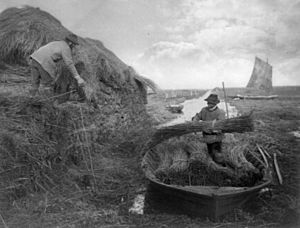Peter Henry Emerson facts for kids
Peter Henry Emerson (born May 13, 1856 – died May 12, 1936) was a British writer and photographer. He was one of the first to say that photography should be a true art form. He believed photos should show things exactly as they are. Emerson was famous for his pictures of country life. He also had many disagreements with other photographers about what photography should be.
Contents
About Peter Henry Emerson
His Early Life
Peter Henry Emerson was born on a sugar plantation in Cuba. His father was American, and his mother was British. He was even a distant relative of Samuel Morse, who invented the telegraph. He spent his early years in Cuba. In 1869, after his father died, he moved to England.
He went to school at Cranleigh School. He was a very good student and athlete there. Later, he studied at King's College London. Then he went to Clare College, Cambridge in 1879. He earned his medical degree in 1885.
Emerson was very smart and well-educated. He also came from a wealthy family. In 1881, he married Edith Amy Ainsworth. He wrote his first book while on his honeymoon. They had five children together.
His Photography Journey
Emerson bought his first camera around 1881 or 1882. He used it to take pictures of birds with his friend, a bird expert named A. T. Evans. In 1885, he helped start the Camera Club of London. The next year, he joined the Council of the Royal Photographic Society. He then stopped being a surgeon to become a full-time photographer and writer. He loved nature, but also enjoyed billiards, rowing, and studying weather.
At first, he wanted his photos to look like natural French paintings. He took very clear, sharp photos of country life. His first photo album came out in 1886. It was called Life and Landscape on the Norfolk Broads. It had 40 special prints that showed his ideas. But soon, he felt that showing everything in sharp focus was not how the human eye sees.
He then tried using soft focus. But he was still not happy. He found it hard to show the depth and feeling of nature accurately. Even with these problems, he took many photos of landscapes. He captured rural life in the East Anglian fenlands. He published seven more photo books over the next ten years. In his last two books, On English Lagoons (1893) and Marsh Leaves (1895), Emerson printed the photos himself. He used a special method called photogravure. He did this because he had bad experiences with other printers.
Later Years and Legacy
After Marsh Leaves was published in 1895, Emerson stopped publishing photos. This book is often seen as his best work. But he kept writing and publishing other books. These included fiction and books on topics like family history and billiards. In 1924, he started writing a history of art photography. He finished it just before he died in Falmouth, Cornwall on May 12, 1936.
In 1979, he was honored. He was added to the International Photography Hall of Fame.
Emerson's Disagreements About Photography
During his life, Emerson often disagreed with other photographers in Britain. In 1889, he published an important book called Naturalistic Photography for Students of the Art. In it, he shared his ideas about art and honest photography. One writer called the book "the bombshell dropped at the tea party." This was because it said that true, realistic photos should replace fake-looking ones.
This was a direct challenge to a popular method called combination printing. This method involved combining many different photos to make one image. Photographers like O. G. Reijlander and Henry Peach Robinson used this in the 1850s. Some of Robinson's photos were made from twenty or more separate pictures. This allowed them to create dramatic images, often like paintings. Emerson said this method was false. He believed photography should be its own art form. It should not try to copy other art forms.
All of Emerson's own pictures were taken in a single shot. He also did not use retouching. This was another way of changing photos that he strongly disliked. He called it "the process by which a good, bad, or indifferent photograph is converted into a bad drawing or painting."
Emerson also thought that a photo should show exactly what the eye sees. He followed ideas about how eyes work. So, he made photos with one part in sharp focus. The rest of the picture would be a bit blurry. He strongly argued for this idea. This made many other photographers uncomfortable.
Another strong belief of Emerson's was that photography was an art. He did not think it was just a way to make copies. He argued with others about this too. But in the end, Emerson had to agree that photography might be a form of mechanical copying. Even so, his own pictures were still seen as artistic. This was because they were not just exact copies. They had depth, thanks to his one-plane-sharp idea. When he lost the argument about photography being art, Emerson stopped showing his work publicly. But he still continued to take photos.
See also
 In Spanish: Peter Henry Emerson para niños
In Spanish: Peter Henry Emerson para niños






